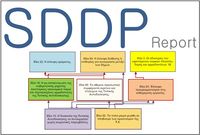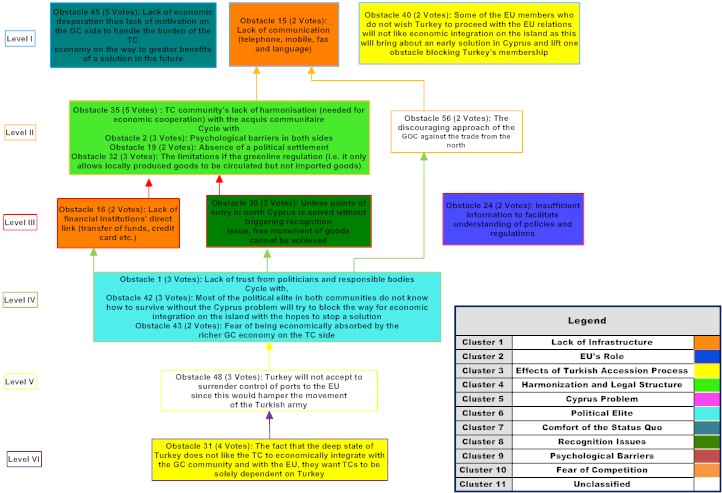SDDP Economic Integration - Obstacles, July 2007 (2nd co-laboratory): Difference between revisions
Jordankent (talk | contribs) |
Jordankent (talk | contribs) |
||
| Line 94: | Line 94: | ||
==External Links== | ==External Links== | ||
[[Category:Projects with | [[Category:Projects with SDD]] | ||
Latest revision as of 06:16, 10 July 2018
SDDP_Economic Integration- Obstacles
|
Executive Summary
Twenty-one business and economics stakeholder representatives with diverse perspectives and experiences participated at the three successive bi-communal workshops on 3, 10 and 27 July 2007. During the first workshop, which was dedicated to jointly visualise and describe the desired situation, i.e. the envisioned Cyprus with respect to economic integration and free movement of goods and services within Cyprus and the EU. Economics and business experts identified 48 factors that describe the benefits / opportunities for Cyprus of free movement of goods and services. The second workshop aimed at identifying the current situation with its obstacles and perceived threats in achieving the envisioned Cyprus—economic integration and free movement of goods and services within Cyprus and the EU. The stakeholder representatives identified 62 of these obstacles and perceived threats. During the final workshop, economics and business experts proposed 27 actions to achieve economic integration in Cyprus and therefore to both overcome the obstacles and to reap the benefits in achieving free movements of goods and services within Cyprus and the EU. The stakeholder representatives were engaged in dialogue sessions that were designed and conducted employing the Structured Dialogic Design Process founded in systems sciences.
Triggering Question
In total, three bi-communal co-laboratories took place in July 2007. For the second one, The Economic Integration co-laboratory - Current Situation explored the obstacles of the current situation and defined the exact nature of the problem, i.e. the problématique. The triggering question that was tackled in this co-laboratory was:
- "With the aim of economic integration; what are the obstacles including perceived threats in achieving free movement of goods and services within Cyprus and the EU?”
Results
Experts participating in this co-laboratory were asked to explore the obstacles of the current situation of Economic Integration. During the second three hour workshop session that took part in Saray Hotel, the participants proposed and clarified responses to the following triggering question:
- "With the aim of economic integration; what are the obstacles including perceived threats in achieving free movement of goods and services within Cyprus and the EU?”
In response to the TQ, the participants, economics and business experts, came up with 62 obstacles or threats in achieving free movement of goods and services within Cyprus and the EU, which were categorized in 11 clusters.
The participants voted for the five obstacles of higher relative importance in the context of the triggering question. Following the voting process, 18 obstacles received two or more votes, but only 3 dominant statements, received 4 or more votes and those were:
Statement # 35: TC community's lack of harmonisation (needed for economic cooperation) with the acquis communitaire (5 Votes).
Statement # 45: Lack of economic desperation thus lack of motivation on the GC side to handle the burden of the TC economy on the way to greater benefits of a solution in the future (5 Votes).
Statement # 31: The fact that the deep state of Turkey does not like the TC to economically integrate with the GC community and with the EU, they want TCs to be solely dependent on Turkey (4 Votes).
The voting results were used to select obstacles for the subsequent structuring phase to identify inter-relations among the generated factors. Participants choose 16 obstacles, which were then structured within six levels and are related according to the influence they exert on each other. Those ideas that appear lower in the Root Cause Map, hence are positioned at the root of the tree, i.e. Level VI, are more influential in terms of influence than those at higher levels and are the ones to tackle preferentially.More specifically,
- Obstacle #31: The fact that the deep state of Turkey does not like the TC to economically integrate with the GC community and with the EU, they want TCs to be solely dependent on Turkey,
located at Level VI in the Map, influences most of the other obstacles appearing on the Map and is therefore a root factor of the overall Economic Integration – Current Situation Root Cause Map (see below).
Interpretation of the Results
At the end of the voting, it was shown that 31 obstacles received one or more votes. Once again, the degree of disagreement – as 31 obstacles or perceived threats out of 62 received at least one vote - indicates the complexity of the situation.
One can easily see with regards to the obstacles and perceived threats that the level of agreement very similar to the agreement level in the idealization session. Once a common vision is designed, it is easier to draw an action plan aimed at solving identified problems or threats. Thus, one should not assume that lack of agreement is a failure in the dialogue or understanding. Rather, it underlines the complexity of the problem.
The above map, displays the relationship among the fourteen obstacles of higher relative importance. As it shows, six levels of obstacles and perceived threats exist in achieving free movements of goods and services within Cyprus and the EU. A directive error in the figure is indicative of a linear relationship between these two obstacles. Two or more obstacles in a bolded box, like Obstacle #1, Obstacle #42 and Obstacle #43 indicate a cyclical relationship among these three obstacles. As seen in the Obstacle map, there are two cycles containing three obstacles each, one at level IV the other at level II.
Such cycles are indicators of the complexity of the situation being addressed and usually require special treatment during the design of an action plan for attaining the ideal image of economic integration and free movement of goods and services within Cyprus and the EU.
The obstacle that emerged as the root cause of the current situation in Cyprus regarding economic integration and free movement of goods in services is: Obstacle #31: The fact that the deep state of Turkey does not like the TC to economically integrate with the GC community and with the EU, they want TCs to be solely dependent on Turkey.
The author of the idea clarified this statement as: “The deep state of Turkey does not want to solve the Cyprus problem. They want to keep integration as a trump card. I remember the chamber of commerce experience, when the EU was trying to do something, like electricity, they would say we would do it for you as part of politicizing”.
It is also very interesting to observe that various trees of influential obstacles end at obstacle #15: Lack of communication (telephone, mobile, fax and language). Clarification: “There is technology through telephone, mobile and fax that would allow us to communicate but the infrastructure is not there and not available at a level that would allow us to communicate”.
Another interesting observation is that two factors (obstacle #46 and 40) on Level I are not related to any other factor structured in the map.
Methodology
The workshop will be conducted through the methodology of "Structured Dialogic Design Process" (Structured Dialogic Design Process, SDDP) known as Structured Democratic Dialogue. The SDDP allows the team involved to discuss an issue with a structured and democratic way that allows us to achieve practical results. It is a deeply reasoned, scientific, psycho-social methodology has evolved over the past 30 years in its current form. Helps build consensus and solve complex problems.
The SDDP workshops contribute the following ways:
- To help participants reach a common understanding of the problem.
- To uncover the root causes (roots of the problem).
- Contribute to the consensual adoption of action plans.
- To create groups dedicated to the implementation of projects.
- to establish lasting ties based on respect, trust, and cooperation.
The SDDP workshops achieve these results through respecting the autonomy of all participants and the use of a toolkit consensus including discipline, technology, and graphics ideas that allow participants to control the discussion. The SDDP methodology developed to help understand and solve complex social systems (complex societal systems). It has been adopted successfully around the world in situations of uncertainty and conflict. At European level, the method has been used by four European networks of experts with participation of about 20 countries each time.
Organizers and partners
The Facilitation Team of these economic integration workshops consisted of:Aleco Christakis, Derya Beyatli, Kevin Dye, Andros Karayiannis, Tatjana Taraszow,and Ilke Dagli

